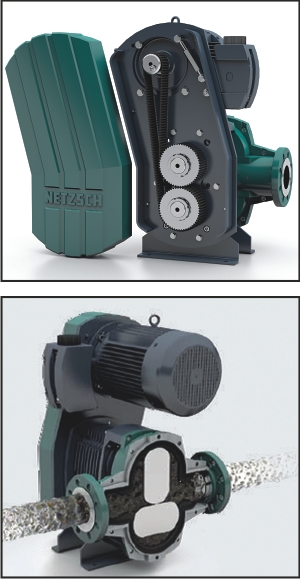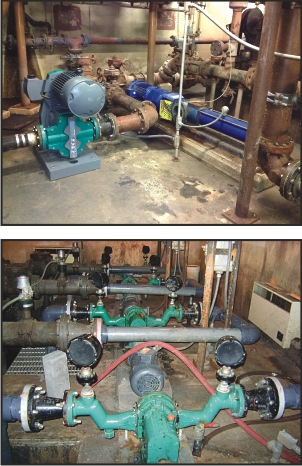Paper and cardboard industry is India’s largest consumer of starch. Carbohydrate-based paste is used to paste various layers of cardboard, for example, though starch solution is in fact primarily used to size the paper surface, making it printable and writeable. However, the medium is very sensitive to pulsation and is very aggressive and capable of corroding conveyors. As a result, the existing centrifugal pumps in a large paper factory had to be replaced. The company replaced its old pumps with Netzsch TORNADO® rotary lobe pumps. The pumps were specially fine-tuned to the highly corrosive material and convey the starch with minimal pulsation and maximum care. The new displacement pumps have also made more accurate dosing possible.
A major portion of the total starch production is consumed by the paper and cardboard industry alone in India. The majority is used to size paper, as untreated paper is hydrophilic due to its structure. Aqueous and low-viscosity ink would otherwise therefore run into the capillaries of the sheet – an effect that can be seen on kitchen paper. Papers and cardboards to be written or printed on are coated with a starch mixture that seals the surface by polymerising the available gluten, thereby making the surface hydrophobic.
Hot starch paste puts real strain on conveyors
The paper factory produces enough paper each year to wrap several times around the earth. More than 150 m³ of starch solution have to be pumped into the coating system every hour at just one of their two sites. The medium is hot at around 80°C – the high temperature ensures that the starch gelatinises. It is only then able to bind many times its own weight in water and form the typical paste consistency. If the heat falls below a certain value, depending on the specific type, the change does not occur. For a long time, centrifugal pumps were used to transport the thick medium that has a viscosity of around 160 mPas. However, the centrifugal pump technology generated a light, but no less undesirable pulsation. The sensitive mixture could not be conveyed sensitively enough, which had a negative impact on the quality. Cavitations and gas-filled bubbles develop easily in centrifugal pumps, which not only reduce the efficiency of the system, but make accurate dosing impossible.
So at the end of 2011, the company decided to switch to TORNADO® rotary lobe pumps to feed the coating system at its main site. The displacement pumps are self-priming to ensure medium in conveyed continuously, with two tuned and intermeshing rotors inside. The rotors generate low pressure on the suction side, which draws the medium without interruption to the lobes, which then convey the medium to the pressure side. As the volume transported is dependent on the speed, the desired quantity can be dosed easily by setting the rotations per minute.
Design modifications and targeted use of materials guarantee uninterrupted transportation
The design can be adapted to the specific application as rotors with two to four blades are available in various forms. Lobes with a three-blade helical geometry were chosen to transport the starch solution with minimal pulsation and maximum care. Ethylene propylene diene monomer (EPDM) rubber was used for the rotors, as it has high thermal and chemical resistance – an important factor when transporting the hot starch. The housing around the rotary lobes, on the other hand, was lined with stainless steel to withstand, over the long term, a medium that can be extremely corrosive. Using traditional materials, the highly corrosive mixture would eat through the sealing surfaces in just a few months and make the pump unusable. Netzsch rotary lobe pumps have a special Gearbox Security System (GSS) that prevents the medium infiltrating the drive by physically separating the gear box and pump chamber to protect the sensitive synchromesh gear, delivering a high degree of operational reliability.
The starch solution is also a challenge for conveyors due to its characteristics as a paste. The shaft seals in particular can stick together very quickly. This is where the simple maintenance and long service intervals of the TORNADO® systems really count. Encapsulated mechanical seals can be used for the shafts and elsewhere, as they are less sensitive to the conveyed medium. The systems also come with a large inspection port that can be easily removed giving spacious access to the pump chamber. The port means that the components can be cleaned easily or replaced as necessary without having to remove all the housing or the pipe work.
Less space-consuming despite increased performance and more gentle transportation
TORNADO® rotary lobe pumps from NETZSCH come in a number of different versions and sizes for media of various consistencies up to 6 bar pressure and for volumes of up to 1,000 m³ per hour. Sticky and dry, thixotropic, dilatant, abrasive and shear-sensitive materials with viscosities of 1 to 1,000,000 mPas can be transported. Even mixtures containing solids with particle sizes of up to 70 mm are not a problem. In one particular instance, a total of three TORNADO® pumps from the largest series, XLB-2, have been installed in the paper factory. Each of the pumps conveys around 80 m³ per hour at a pressure of 1.8 bar and at roughly 375 rotations per minute, ensuring that the coating system used to impregnate the paper is constantly supplied. Thanks to their compact design, the new conveyor systems need even less space than the old centrifugal pumps. The new pumps are also significantly more efficient and transport the starch more smoothly.





